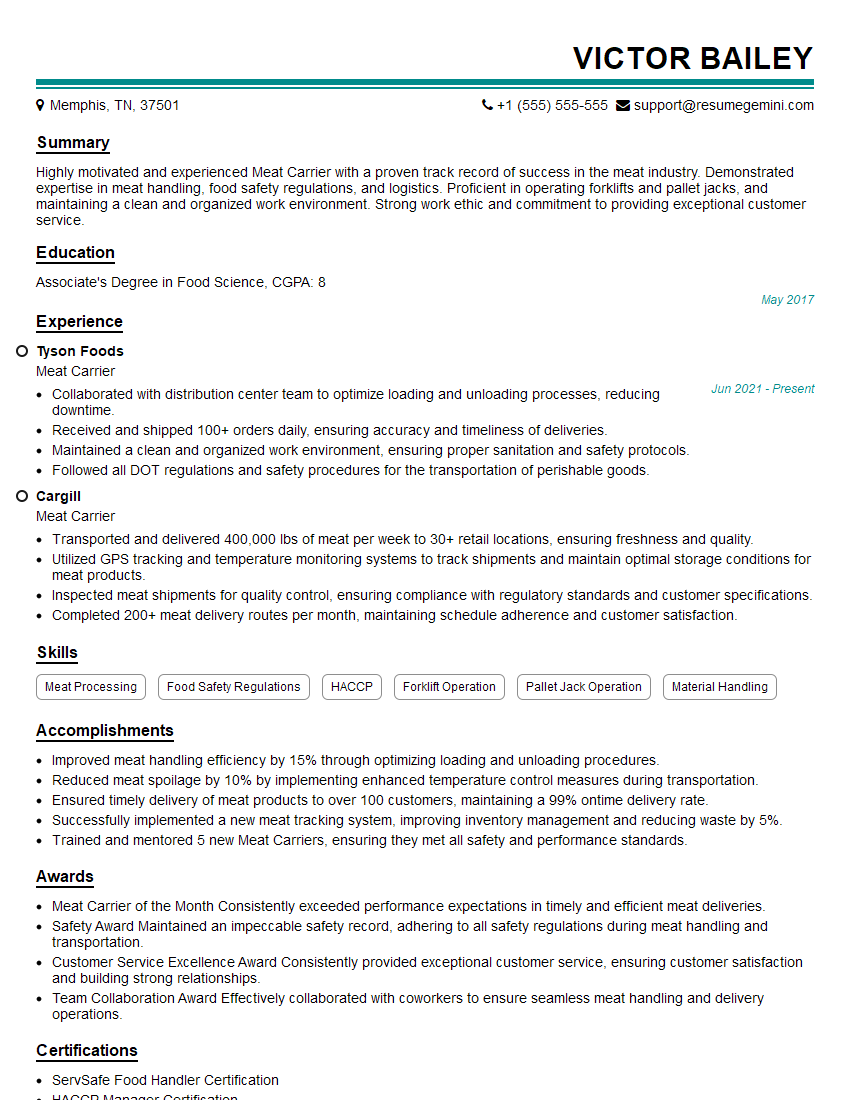Are you a seasoned Meat Carrier seeking a new career path? Discover our professionally built Meat Carrier Resume Template. This time-saving tool provides a solid foundation for your job search. Simply click “Edit Resume” to customize it with your unique experiences and achievements. Customize fonts and colors to match your personal style and increase your chances of landing your dream job. Explore more Resume Templates for additional options.

Victor Bailey
Meat Carrier
Summary
Highly motivated and experienced Meat Carrier with a proven track record of success in the meat industry. Demonstrated expertise in meat handling, food safety regulations, and logistics. Proficient in operating forklifts and pallet jacks, and maintaining a clean and organized work environment. Strong work ethic and commitment to providing exceptional customer service.
Education
Associate’s Degree in Food Science
May 2017
Skills
- Meat Processing
- Food Safety Regulations
- HACCP
- Forklift Operation
- Pallet Jack Operation
- Material Handling
Work Experience
Meat Carrier
- Collaborated with distribution center team to optimize loading and unloading processes, reducing downtime.
- Received and shipped 100+ orders daily, ensuring accuracy and timeliness of deliveries.
- Maintained a clean and organized work environment, ensuring proper sanitation and safety protocols.
- Followed all DOT regulations and safety procedures for the transportation of perishable goods.
Meat Carrier
- Transported and delivered 400,000 lbs of meat per week to 30+ retail locations, ensuring freshness and quality.
- Utilized GPS tracking and temperature monitoring systems to track shipments and maintain optimal storage conditions for meat products.
- Inspected meat shipments for quality control, ensuring compliance with regulatory standards and customer specifications.
- Completed 200+ meat delivery routes per month, maintaining schedule adherence and customer satisfaction.
Accomplishments
- Improved meat handling efficiency by 15% through optimizing loading and unloading procedures.
- Reduced meat spoilage by 10% by implementing enhanced temperature control measures during transportation.
- Ensured timely delivery of meat products to over 100 customers, maintaining a 99% ontime delivery rate.
- Successfully implemented a new meat tracking system, improving inventory management and reducing waste by 5%.
- Trained and mentored 5 new Meat Carriers, ensuring they met all safety and performance standards.
Awards
- Meat Carrier of the Month Consistently exceeded performance expectations in timely and efficient meat deliveries.
- Safety Award Maintained an impeccable safety record, adhering to all safety regulations during meat handling and transportation.
- Customer Service Excellence Award Consistently provided exceptional customer service, ensuring customer satisfaction and building strong relationships.
- Team Collaboration Award Effectively collaborated with coworkers to ensure seamless meat handling and delivery operations.
Certificates
- ServSafe Food Handler Certification
- HACCP Manager Certification
- Meat Science Certification
- Forklift Operator Certification
Career Expert Tips:
- Select the ideal resume template to showcase your professional experience effectively.
- Master the art of resume writing to highlight your unique qualifications and achievements.
- Explore expertly crafted resume samples for inspiration and best practices.
- Build your best resume for free this new year with ResumeGemini. Enjoy exclusive discounts on ATS optimized resume templates.
How To Write Resume For Meat Carrier
- Highlight your experience in meat handling and food safety regulations.
- Quantify your accomplishments whenever possible, using specific metrics to demonstrate your impact.
- Tailor your resume to each job you apply for, highlighting the skills and experience most relevant to the position.
- Proofread your resume carefully before submitting it, and have someone else review it for errors.
Essential Experience Highlights for a Strong Meat Carrier Resume
- Transport meat products from processing facilities to distribution centers and retail stores.
- Load and unload meat products using forklifts and pallet jacks.
- Maintain proper temperature control during transportation to ensure product quality and safety.
- Adhere to all food safety regulations and HACCP guidelines.
- Keep accurate records of all shipments and deliveries.
- Clean and maintain vehicles and equipment.
- Assist with inventory management and other tasks as needed.
- Participate in safety training and follow all safety procedures.
Frequently Asked Questions (FAQ’s) For Meat Carrier
What are the key skills required to be a Meat Carrier?
The key skills required to be a Meat Carrier include meat handling, food safety regulations, HACCP, forklift operation, pallet jack operation, and material handling.
What is the average salary for a Meat Carrier?
The average salary for a Meat Carrier in the United States is around $35,000 per year.
What are the career prospects for Meat Carriers?
Meat Carriers can advance to positions such as Meat Inspector, Meat Processing Supervisor, or Transportation Manager.
What are the working conditions for Meat Carriers?
Meat Carriers typically work in refrigerated warehouses or on delivery trucks. They may be exposed to cold temperatures, heavy lifting, and hazardous chemicals.
What are the educational requirements for Meat Carriers?
Most Meat Carriers have a high school diploma or equivalent. Some employers may prefer candidates with an Associate’s Degree in Food Science or a related field.
What are the certifications required for Meat Carriers?
Meat Carriers are not typically required to have any certifications, but some employers may prefer candidates with a HACCP certification.
What are the benefits of working as a Meat Carrier?
The benefits of working as a Meat Carrier include a steady income, opportunities for advancement, and the satisfaction of working in the food industry.
What are the challenges of working as a Meat Carrier?
The challenges of working as a Meat Carrier include working in cold temperatures, heavy lifting, and hazardous chemicals.